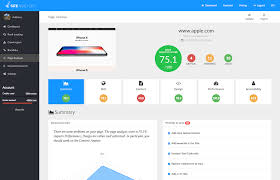SEO Site Analysis Tool: A Comprehensive Guide
Search Engine Optimization (SEO) is crucial for any website looking to increase its visibility and ranking on search engine results pages. One of the key components of a successful SEO strategy is conducting regular site analysis to identify areas for improvement. This is where an SEO site analysis tool comes in handy.
What is an SEO Site Analysis Tool?
An SEO site analysis tool is a software or online service that helps website owners and marketers assess the performance of their websites in terms of SEO. These tools provide valuable insights into various aspects of a website, such as on-page and off-page SEO, technical issues, content quality, backlink profile, and more.
Key Features of an SEO Site Analysis Tool
- Keyword analysis to determine the relevance and competitiveness of target keywords.
- On-page analysis to evaluate factors like meta tags, headings, content quality, and internal linking.
- Backlink analysis to assess the quantity and quality of inbound links pointing to the website.
- Technical audit to identify issues such as broken links, page speed problems, mobile-friendliness, and more.
- Competitor analysis to benchmark your website against competitors and identify opportunities for improvement.
Why Use an SEO Site Analysis Tool?
By using an SEO site analysis tool, website owners can gain valuable insights into their website’s performance and discover areas that need attention. These tools can help identify weaknesses in the current SEO strategy, uncover new opportunities for growth, and track progress over time. Ultimately, an SEO site analysis tool empowers users to make informed decisions that can lead to improved search engine rankings and increased organic traffic.
Conclusion
An SEO site analysis tool is an essential resource for anyone serious about improving their website’s visibility and performance in search engine results. By leveraging the features and insights provided by these tools, website owners can take proactive steps towards enhancing their SEO strategy and achieving better results online.
Maximising Website Performance: 9 Essential Tips for Using an SEO Site Analysis Tool
- Choose a comprehensive SEO site analysis tool that covers various aspects of on-page and off-page SEO.
- Regularly use the tool to monitor your website’s performance and identify areas for improvement.
- Pay attention to key metrics such as organic traffic, backlink profile, keyword rankings, and site speed.
- Utilize the tool’s competitor analysis feature to benchmark your site against others in your industry.
- Look for insights on technical SEO issues like crawl errors, broken links, and mobile-friendliness.
- Optimize your content based on the tool’s recommendations for keywords, meta tags, headings, and internal linking.
- Monitor changes in search engine algorithms and adapt your strategy using data from the analysis tool.
- Integrate the SEO tool with other analytics platforms to get a holistic view of your website performance.
- Stay updated with new features and updates of the SEO analysis tool to make the most out of its capabilities.
Choose a comprehensive SEO site analysis tool that covers various aspects of on-page and off-page SEO.
When selecting an SEO site analysis tool, it is advisable to opt for a comprehensive solution that addresses a wide range of on-page and off-page SEO factors. By choosing a tool that covers aspects such as keyword analysis, content quality assessment, backlink profile evaluation, technical audit, and competitor analysis, website owners can gain a holistic view of their website’s SEO performance. This comprehensive approach allows for a thorough examination of different elements influencing search engine rankings, enabling users to identify areas for improvement and develop effective strategies to enhance their online visibility and organic traffic.
Regularly use the tool to monitor your website’s performance and identify areas for improvement.
Regularly utilising an SEO site analysis tool to monitor your website’s performance is essential for maintaining a strong online presence. By consistently reviewing the data and insights provided by the tool, you can effectively identify areas that require improvement and take proactive steps to enhance your website’s SEO strategy. This approach not only helps in addressing issues promptly but also allows you to track progress over time, ensuring that your website remains optimised for search engines and continues to attract organic traffic.
Pay attention to key metrics such as organic traffic, backlink profile, keyword rankings, and site speed.
When utilising an SEO site analysis tool, it is crucial to pay close attention to key metrics that can significantly impact a website’s performance and visibility. Monitoring organic traffic levels provides insights into the effectiveness of your SEO efforts in attracting visitors from search engines. Evaluating the backlink profile helps assess the quality and quantity of inbound links pointing to your site, which can influence search engine rankings. Tracking keyword rankings allows you to understand how well your website is positioned for relevant search terms. Additionally, monitoring site speed is essential for ensuring a positive user experience and improving search engine rankings. By focusing on these key metrics with the help of an SEO site analysis tool, website owners can make informed decisions to enhance their SEO strategy effectively.
Utilize the tool’s competitor analysis feature to benchmark your site against others in your industry.
Utilizing the competitor analysis feature of an SEO site analysis tool is a strategic tip to gain valuable insights into how your website stacks up against others in your industry. By benchmarking your site against competitors, you can identify strengths and weaknesses, uncover new opportunities for improvement, and fine-tune your SEO strategy to stay ahead in the competitive online landscape. This feature allows you to track competitor performance metrics, analyse their keyword strategies, and learn from their successful tactics, enabling you to make informed decisions and drive continuous growth for your website.
Look for insights on technical SEO issues like crawl errors, broken links, and mobile-friendliness.
When utilising an SEO site analysis tool, it is crucial to focus on gaining insights into technical SEO issues that can significantly impact a website’s performance. By prioritising areas such as crawl errors, broken links, and mobile-friendliness, website owners can address critical issues that may hinder their site’s visibility and ranking on search engines. Identifying and rectifying these technical SEO issues not only enhances the user experience but also signals to search engines that the website is well-maintained and optimised for modern browsing trends.
Optimize your content based on the tool’s recommendations for keywords, meta tags, headings, and internal linking.
To enhance your website’s SEO performance using an SEO site analysis tool, it is crucial to optimise your content based on the tool’s recommendations. Pay close attention to suggested improvements for keywords, meta tags, headings, and internal linking. By aligning your content with these recommendations, you can improve the relevance and visibility of your website in search engine results. Implementing these optimisations will not only enhance your website’s SEO friendliness but also increase the likelihood of attracting organic traffic and improving overall user experience.
Monitor changes in search engine algorithms and adapt your strategy using data from the analysis tool.
To enhance your SEO strategy effectively, it is crucial to monitor changes in search engine algorithms and adjust your approach accordingly. By utilising data from an SEO site analysis tool, you can stay informed about algorithm updates and trends that may impact your website’s ranking. This proactive approach allows you to adapt your strategy in real-time, ensuring that your site remains optimised for search engines and maintains its visibility in search results. Keeping a close eye on algorithm changes and leveraging insights from the analysis tool enables you to make informed decisions that support the long-term success of your website in the ever-evolving digital landscape.
Integrate the SEO tool with other analytics platforms to get a holistic view of your website performance.
Integrating your SEO site analysis tool with other analytics platforms is a valuable tip to gain a comprehensive understanding of your website’s performance. By combining data from various sources, such as website traffic, user behaviour, and search engine rankings, you can obtain a holistic view of how your site is performing across different metrics. This integration allows you to identify correlations, trends, and insights that may not be apparent when looking at individual data sets in isolation. By leveraging the power of multiple analytics platforms in tandem with your SEO tool, you can make more informed decisions and optimise your website for improved visibility and success online.
Stay updated with new features and updates of the SEO analysis tool to make the most out of its capabilities.
To make the most of your SEO site analysis tool, it is crucial to stay updated with new features and updates that are regularly released. By keeping abreast of the latest enhancements, you can leverage the full capabilities of the tool to improve your website’s SEO performance effectively. Continuous learning and adaptation to new functionalities will enable you to stay ahead in the ever-evolving landscape of search engine optimization, helping you achieve better results and maintain a competitive edge in online visibility.
Tags: backlink profile, backlink profile evaluation, competitor analysis, content quality assessment, keyword analysis, keyword rankings, off-page seo, on-page analysis, organic traffic, seo site analysis tool, site speed, technical audit

I’m really enjoying the design and layout of your site.
It’s a very easy on the eyes which makes it much more pleasant for
me to come here and visit more often. Did you hire out a designer to create your theme?
Excellent work!
Thank you for your kind words! We’re glad to hear that you’re enjoying the design and layout of our site. Our team worked hard to create a user-friendly experience that complements the valuable information we provide about SEO site analysis tools. We appreciate your feedback and hope you continue to find our content helpful.